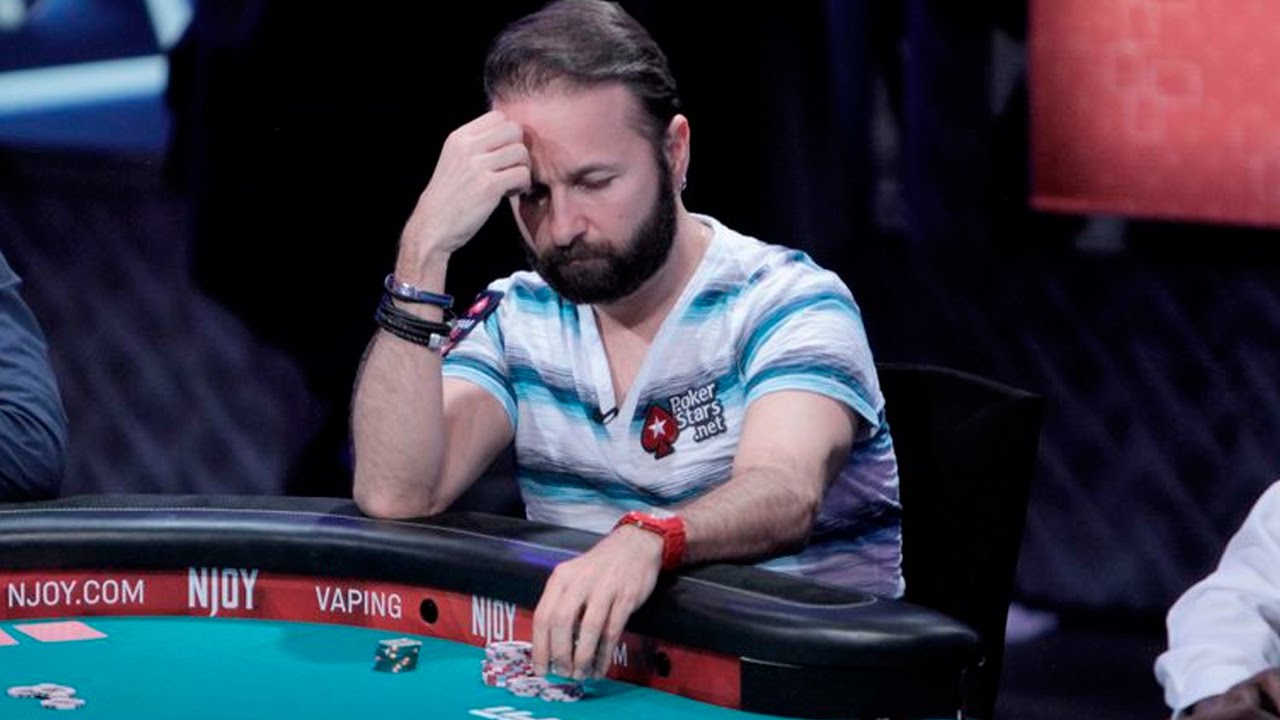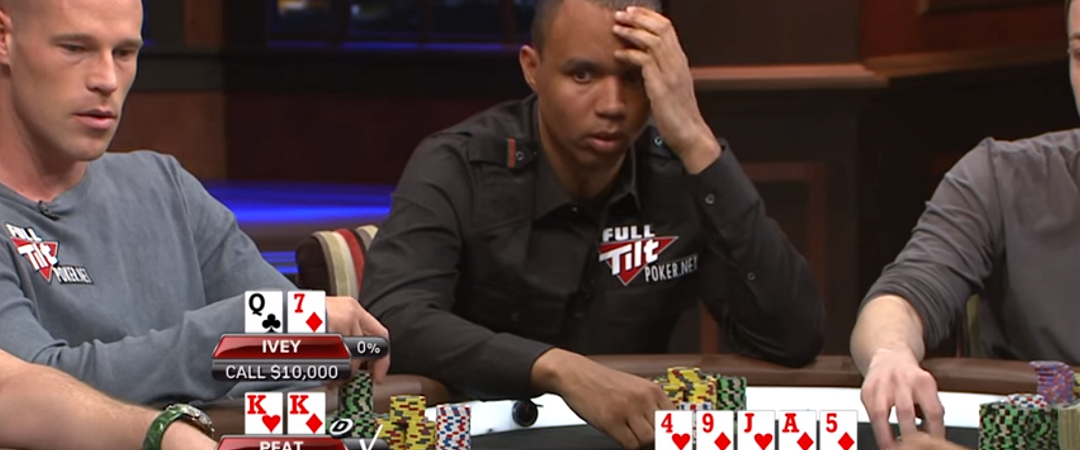
Above - Antonio "The Magician" Esfandiari shows his skills
If you’re new to the game, or still relatively inexperienced, then a cheat sheet is exactly what you need – a handy reference guide open next to you when you’re facing all those tricky decisions and unusual choices which poker will throw at you!
Which hand is strongest? How likely are you to turn your pair into a set on the flop? What are your chances of hitting that flush on the river? If you have pocket kings, what are the chances that someone has pocket aces?
Quick fact: Use the below cheat sheets at your own poker party at home!
Did you know that poker parties are getting more and more popular around the world?
Especially Norwegians love to play poker at online casinos and you are even legally allowed to hold gambling and poker parties at home unless you don't organize them for business purposes.
Below - Table position is often the difference between winning a hand and losing one.

Poker Hand rankings (best to worst)
Royal Flush
10, J, Q, K, A all of the same suit
e.g. AKQJ10
This is the best hand in poker – nothing else can beat it!
Straight Flush
5 cards in a row, all of the same suit
e.g. 56789
Not seen very often but the 2nd strongest hand in poker
Four of a Kind
4 cards of the same rank
e.g. 5555Q
Hold this hand and you’re extremely unlikely to lose
Full House
Three cards of the same rank plus a pair
e.g. KKK99
This is the strongest hand which you will see on a regular basis
Flush
5 cards of the same suit, but not in a row
e.g. KQ985
The higher your best card (e.g. if you hold the ace here) the stronger your flush is
Straight
5 cards in a row, but not all the same suit
e.g. 56789
Not as good as the ‘straight flush’ because it’s more likely to have this unsuited version of the hand
Three of a kind
3 cards of the same rank
e.g. 777102
Often a hand good enough to win a show-down
Two pair
2 lots of 2 cards of the same rank
e.g. QQ10109
Although it looks good, it’s not nearly as strong as you might think
One pair
Any 2 cards of the same rank
e.g. 77Q106
The higher your pair, the better – aces are always highest
High card
Exactly what it sounds like, a high card
e.g. 267JA
Below - Showdown: after the final round of betting, the remaining players reveal their cards to find out who has the best hand.

♣ ♠ ♦ ♥
Poker Betting Options
There are a few simple actions you need to know when it comes to playing your cards.
Fold: This ends your participation in a hand – you lose any money you have already and y invested in it.
Check: You don’t fold, but stay in the hand if no-one else has bet on any particular round.
Bet: You opt to put money into the pot. The amount can vary depending in the rules and/or personal choice.
Call: You match any bet already made by opponent(s) and therefore remain in the hand.
Raise: Putting extra money in the pot over and above that needed to simply call.
Below - Daniel Negreanu raising the stakes

♣ ♠ ♦ ♥
How a hand is played in No Limit Hold’em
Texas Hold’em is a fairly simple game and can be picked up very quickly. Our move-by-move poker cheat sheet described below should keep you right if you’re not sure what’s going on...
- The blinds (small and big) are placed and the dealer shuffles the cards.
- All players are dealt two cards face down, known as "hole" cards.
- The 1st round of bets are placed, moving clockwise after the blinds
- Players must match the highest previous bet in the round or fold (see above)
- The dealer discards –or ‘burns’- the top card on the deck
- The dealer deals three ‘community’ cards face-up on the table-known as ‘the flop’
- A 2nd round of betting takes place, beginning with the player to the left of the dealer
- The dealer burns another card, then deals a single card face-up- known as ‘the turn’
- A 3rd round of betting commences, in the same way as the 2nd round
- The dealer burns another card, then deals a 5th card face-up – known as ‘the river’
- Players make the best 5-card hand they can, using the table ‘community’ cards and their own hole cards
- A final round of betting takes place, in the same way as the 2nd and 3rd rounds.
- The players reveal their hands, clockwise from the last player called -the showdown. Players may ‘muck’ their cards (i.e. push them face-down to the dealer) if they know they are beaten and don’t want to show what they were holding
- The winning hand takes the ‘pot’ (the money in the middle from the betting plus blinds)
Below - Phil Hellmuth victorious in $10K Razz for Bracelet Number 14

♣ ♠ ♦ ♥
The Numbers Game
Poker is a game which not only involves cards and bluffs and reading your opponents’ intentions – it also requires a knowledge of some numbers if you want to play the game well.
You hold a pocket pair
- Probability/Odds of flopping a set or better 10% (8.5-1)
- Probability/Odds of flopping a set 12% (7.5-1)
- Probability/Odds of making a set or better by the river 19% (19.2%)
Flop probability and odds
1. Probability/odds of hitting your flush by the river
e.g. you have AK and the flop comes 9104 34.5% (1.9-1)
2. Probability/odds a set will improve to a full house or better
e.g. you have 1010 and the flop comes 1085 33.3% (2-1)
3. Probability/odds two pair will improve to a full house or better
e.g. you have JQ and the flop comes JQ6 16.4% (5-1)
Turn probability and odds
1. Probability/odds of hitting your flush by the river 19.6% (4-1)
e.g. you have AK the turn comes 91045
2. Probability/odds a set will improve to a full house or better 21.7% (3.6-1)
e.g. you have 1010 the turn comes 10857
3. Probability/odds two pair will improve to a full house or better 8.33% (11-1)
e.g. you have JQ the turn comes JQ65
♣ ♠ ♦ ♥
Starting hands guide
Which cards to play and when to play them?
If you try to play any two cards all the time, you’ll soon find yourself losing all your money! You need to learn which cards should be played and when.

Early position (seats 1,2 and 3): Here you need to remember that there are a lot of players to act after you, so make sure you play only the top percentage of cards, so:
AA – 99
AK-AJ suited or unsuited
KQ-KJ suited
Middle position (seats 4, 5 and 6): There are less players to act after you, so you can relax your starting hands a bit, e.g.
AA-77
AK-A9 suited or unsuited
KQ-K10 suited
QJ suited
Late position (seats 7, 8 and 9): Because there are very few players left to act after you, you can relax your requirements a lot more, so:
AA-55
KQ-K7 suited or unsuited
QJ-J10 suited or unsuited
These are quite tight requirements, but they’ll help you to understand the strength of hands which will appear at your table.
Note that if someone acts before you, you will have to tighten up which cards you play – a basic plan is to only play the top half of all these hands if someone has bet before you. If you plan to raise, do it with the top 20% of your starting hands.
If you are playing 6-max tables, simply shift the plan above to the left! Your middle position hands now become your early position cards (including all the bigger hands)
If you find yourself heads-up, pretty much every starting hand can be played, but to begin with you should stick to everything in the top 50% of hands until you get used to how it works with few players.
Below - Phil Ivey's hero call.

One important point to note is, you should never limp in – always raise! There are some tricky plays involving limping, but for those new to the game it’s simply a bad idea to get ‘fancy’. If your raise gets re-raised, then call or – with your very top 10% of hands – re-raise again. You can go all the way with your top 5% of cards.
Being bullied at the table is horrible, so you must get into the habit of fighting back! Choose your top 20% of cards per position and shove back against the table bully. You’ll lose a few, but the bully will soon learn you are not to be messed with.
This is especially true when you are in the Big Blind! Don’t allow the Small Blind to walk all over you.
♣ ♠ ♦ ♥
We hope you've enjoyed our ultimate Texas hold'em poker cheat sheet! It's definitely a useful starting point for you to get to grips with the hand values, numbers and playing of NoLimitHold’em. Keep this close to hand and you’ll find poker a far easier game.
 More Top Rated Content
More Top Rated Content
Articles
- How to Make a Poker Schedule - Tools You Can Use
- Motivational YouTube Videos - Friend or Foe?
- How to Get in the Zone and Play Your Best Poker
Coaching Videos

